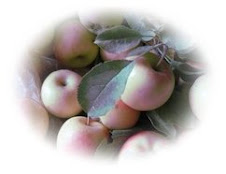

English Scones... or Chrissie's Scones. I've been blogging for some time now... well, since Sep. 2008, if you can believe it! I've enjoyed blogging, more as a personal hobby of mine... as a way to document the recipes I try... and to share them(mostly with my immediate family). I never once thought I would have a follower... or that someone would take the time to leave an encouraging comment. Truth be told, I never expected anyone to be interested in my little corner of the world... I blogged because I wanted to. Not because someone made me... or because "everyone" was doing it. Cooking and baking has been a passion of mine since childhood... I wasn't a picky eater(my mom can attest to that:))... and I loved food. Loved to watch cooking shows...
We hardly ever watched t.v. while growing up, so it was a special treat when my parents allowed us to watch a few select shows... once a week, on PBS, at 5:30 p.m. Floyd on France would come on. We left all school work aside and gathered as a family to watch. Later on, we watched Julia Child and Jacques Pepin... and so on. I grew up eating healthy, homemade food... so I was always interested in food. I found out I LOVED being in the kitchen.... and could spend hours cooking or baking all by myself.
I've been blogging about recipes that I personally love... not knowing that others, all over the world, would ever be interested in the recipes I posted. I've truly been overwhelmed... but I know full well, that God deserves the credit in all this. When I realized that traffic was increasing on my site, I slowly "cleaned house" and tried my best to be hospitable... to answer questions the best I could, to take better photos, to write recipes in a more detailed fashion, and to share tips and ideas, as well as step-by-step photos. I wanted my blog to be a warm and inviting place... a place where others would get inspired. Ultimately, I wanted my blog to be a blessing.... and nothing more than that.
I realize that not all of the recipes I've posted will have been a success for everyone... all of us have different tastes and preferences... and sometimes ingredients and various factors(I live at 5000 ft) don't allow us to duplicate the recipes exactly... "like in the picture". I'm not the type of person that will withhold a "secret" ingredient from a recipe.... just because I don't want someone else to duplicate it. On the contrary, I'll try my best to reveal all that I know...despite my limited knowledge. Nonetheless, I've been thrilled to hear the success stories from my readers.
Over the years, I've been blessed to "meet" other bloggers who share the same passion as myself.... But I never expected to hear from readers expressing their thankfulness for a recipe they've tried and enjoyed immensely. I've received many emails that have humbled and overwhelmed me... appreciated the fact that someone would take the time to write. I've been truly thankful! You know, blogging isn't an easy "job"... there's lots of editing, taking photos, rearranging, writing, and finally posting. Sometimes I overdo all this... too many photos, too many tips, too many words. But my purpose is to make the recipes as user-friendly as possible. All this takes time... but it's something I do because I love to... not because I expect a reward from others.
Sometimes though, you do get rewarded... in ways that just humble you. Readers share some of their favorite recipes with you... because they noticed you've been looking for a recipe... or maybe because they think you would love to try a new recipe. Such was the case recently...
Chrissie noticed that I was looking for a "mile-high" scone recipe(see FAQS)... and she instantly emailed me her recipe( along with a few other recipes). I tried the scone recipe... and simply loved it! Chrissie makes really beautiful cakes... and she was willing to share some of her favorite recipes with me. Not everyone does. She did. She even let me post it. Chrissie, thank you for your kindness.
Though I've posted other scone recipes in the past, I just feel you can't have too many scone recipes:)...scones are probably one of my weaknesses. I simply love to relax with a cup of tea and a scone. This scone recipe reminds me of the scones I had while in London... a little sturdier in texture(probably because of the strong flour)....but definitely not crumbly. It's not overly fluffy, but tender enough... It's the type of scone that requires some clotted cream and jam... sort of reminds me of the NY Times Version. I love this recipe because it makes plenty of large scones... and they come out looking so beautiful! The scones are best served a bit warm. Hope you enjoy...
Note: For the flour, I used KAF bread flour, though you can easily use all purpose flour as well...which is more widely used. Also, as I didn't have any whole milk on hand, so I used 3/4 cup (2% milk) + 1/4 cup heavy cream = 1 cup whole milk.
The extracts are my addition.... add if you like, or simply omit.
It is best to weigh the ingredients, but I have included the cup measurements(as I measured)... for those who don't have a scale.
The butter wasn't overly soft... soft, yet slightly firm( sort of like the consistency of shortening).
Tip: I noticed that a tall, sharp biscuit cutter will make the scones rise much higher. My biscuit cutter had a handle that sort of got in the way and pinched the sides of the scones a bit. Also, I noticed that if you cut the biscuits inside the border... and not cutting right at the edge, you'll have better rising scones. That's because the edges have been handled a bit and can "seal"...which can impede the scones from rising to their full potential. I noticed that with mine...
~I think a fluted tall biscuit cutter works even better... as well as cutting the scones a bit smaller. I used a 1 1/2 inch square fluted biscuit cutter with the re-rolled scraps( placed the scraps on top of each other, then gently rolled out the dough). Those scones rose very high... even when re-rolled!
~Though I didn't refrigerate the cut biscuits before baking...I don't think it would be a bad idea to do so( for 20 -30 minutes).
You will need: adapted from Chrissie of Manx Classic Cakes... makes 9 large(3 inch) scones and a few smaller scones from the scraps. Obviously, if you make the scones smaller, you'll
get even more.
450 g(3 1/3 cup) strong white flour, plus an extra 50g for dusting*
5 tsps baking powder
75 g(5 TBS) softened butter(or at cool room temp.)
75 g(1/3 cup) caster sugar
2 large free-range eggs, beaten (mine were from the fridge)
250 ml( 1 cup) full-fat milk, (mine was cold)
1 egg yolk, beaten with 1 tsp milk, to glaze
1/2 tsp almond extract, optional
1 tsp vanilla extract, optional
* I didn't use all 50 grams of extra flour... just enough so that the dough wouldn't stick to the work surface.
Additional:
clotted cream, mascarpone, or creme fraiche
jam, preserves
lemon curd
Directions:
1. Preheat the oven to 220C/200C fan/gas 7.( or 425 deg F) I cooked mine at 400F, though I think 425 F is best.
~Line a large baking tray with parchment paper~.
2. Put the flour and baking powder in a large mixing bowl and add the butter. Rub the butter and flour gently between your fingertips until the mixture resembles breadcrumbs.
3. Mix the sugar and eggs... and extracts, if using. Pour over the butter/flour mixture, stirring and turning the mixture with a wooden spoon....or you could use a fork here.
4. Add the milk, in two or three equal amounts, turning the mixture gently with each addition until you have a wet dough.
5. Scatter some of the extra flour onto a work surface and tip the dough on top... scraping any dough that may have stuck to the bottom of the bowl. Using your hands, gently fold the dough into the flour, turning as you go to create a smooth, airy, soft dough.... you can accomplish this by folding the dough in half, then turn the dough 90 degrees and repeating. Folding and turning the mixture will add air. Do this a couple of times until you’ve formed a smooth dough. Try not to overwork the dough....or the scones will come out tough.

6. Scatter any remaining flour onto the dough and your rolling pin, and lightly roll the dough to about 2.5cm(1 inch) thick, taking care not to stretch the dough, and allowing it to relax back into shape once rolled by gently lifting the edges.
7. Cut out circles with a floured 7cm( I used a 3 inch) pastry cutter, making sure you don’t twist the cutter. You want to use a sharp biscuit cutter, so that the edges of the scone will have a clean cut...which ensures your scones will rise evenly. If the edges of the dough gets pinched down, the scone won't rise as high.
8. Put the scones close together on the prepared tray and gently re-roll and cut the remaining dough until you have used it all. I placed the scraps on top of each other and then rolled it out gently.
9. Brush the tops of the scones only with the egg wash and leave them to sit for 1-2 minutes. Try to keep the egg wash on the top of the scones only... if it runs down the sides it will stop them from rising evenly.
10. Bake in a preheated oven... middle rack... for about 15 minutes, or until golden and risen.
11. Cool just slightly before serving.


































